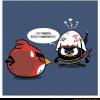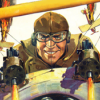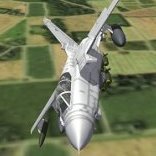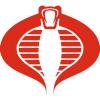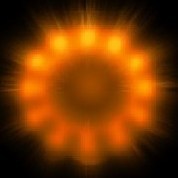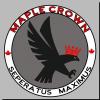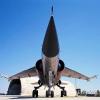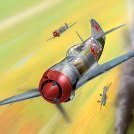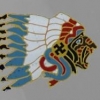Leaderboard
Popular Content
Showing most liked content on 03/06/2018 in all areas
-
13 points
-
4 points@ Stratos, cause you 've asked for more pics, and couldn't find any at Enocs profile, here are a few more. I have noticed it still has the old intake, i need to upgrade it with the new "parts"
-
4 points
-
This post cannot be displayed because it is in a password protected forum. Enter Password
-
3 pointsGrumman F-14A Tomcat - Ala 12, Ejército del Aire, 1982 By the late 1970's the Phantom F-4C's of 12 Ala (12th Wing) were becoming increasingly long in the tooth and the Ejercito del Aire urgently sought a replacement. McDonnell Douglas appeared to have the upper hand with no less than three products on offer; The F-4E Phantom (still in low-rate production). The F-15C Eagle. The F/A-18A Hornet. However, during 1978 the situation in Iran was becoming increasingly unstable and by January 1979 the Shah of Iran had fled in exile. An immediate arms embargo to Iran soon followed and Grumman were left with a considerable number of undelivered and now undeliverable Iranian F-14A Tomcats. A formal approach to Spain was made by Grumman and agreement was soon reached for the supply of 30 F-14A's to replace the Phantom F-4C's of No.121 and No.122 Escuadrons with a small follow-on batch of 10 F-14R's to supplement and eventually replace the RF-4C's of No.123 Escuadron. The F-14A Tomcat gave good service to the Ejercito del Aire before being phased out during 2007 and 2008 and replaced by Boeing Hornet F/A-18F's.
-
3 points
-
3 pointsI feel this mods are getting such an outstanding quality level that in some cases surpases commercial modules for DCS. My hat off for you guys!
-
3 points
-
3 pointsPerhaps something like this? Might need to increase the volume numbers further but here's a (beta) emitter for testing, can also be used for the stock ships by being renamed to ShipStaticSmoke (as always for emitters, install into the Effects folder). This is simply a mod of the Stephen1918/Ojcar smoke effect for static ships. Other possibilities include linking coal-burning ships with the aircraft smoke emitter file, although that might hit frame-rates on medium and low-end rigs. Von S [removed old link - see latest FM/realism packages for FE2 for relevant atmospheric and other tweaks]
-
3 points
-
2 pointsBeen corresponding with gterl about objects for the Mark 2 version of his Italian front map. Among other things, he requested some maritime objects. First experiments below. I'm tinkering with a wake concept that would be a transparent plane on the water surface, part of the LOD. While it would not be dynamically animated, anything would be better than the stock game's wake.
-
2 pointsThe USS Lexington has been found, after 76 years: https://www.afp.com/en/news/23/wreckage-found-wwii-aircraft-carrier-uss-lexington-doc-1201xk2 God bless all the heroes who served and died aboard her.
-
2 pointsYou can say a lot of things about Paul Allen, and not all of them are nice, but he deserves a thank you for his efforts. And yes, it needs to be left undisturbed. It is an honorable place of resting for those souls departed.
-
2 pointsNorthrop fighter programs and luck are not things you will often hear in the same sentence. Here we look at the short lived Tigershark and some of its contenders for the lucrative 1980s export market. In the 1960s and through the 1970s Northrop produced and sold the superb F-5AB Freedom Fighter and F-5EF Tiger II to the export Foreign Military Sales (FMS) market. In fact over 30 countries had procured 2600 F-5s in 28 different configurations by the mid-1980s. In the late 1970s Taiwan had a requirement for a fighter that could fire BVR missiles like the AIM-7 – unfortunately the US government had to appease mainland China so the F-4/F-16/F-18 were out……… and so the US Department of Defense (DOD) asked Northrop to adapt the F-5E. F-5E Aggressor (Airliners.net) Sadly, with AIM-7s and a bigger radar, performance of the new F-5E was lackluster and Taiwan was not interested. So, the DoD asked Northrop to look into a more suitable configuration, which ended up with a new F404 engine and the designation of F-5G. The Carter administration at the time decided to put a cap on exports to certain developing countries and stipulated the US would only export fighters that were modifications of existing aircraft and thus "inferior" to US front line fighters. Also, any company submitting proposals had to fund it themselves! The ruling favoured the less advanced F-5G and not the F-16A, so with Northrop already having the F-5 market to themselves it sounded like a risk worth taking. The FX proposal (F-5G Vs the F-16-79) The requirement for the FX was for a fighter with performance somewhere between the F-5E and the F-16A, and so Northrop and General Dynamics submitted their proposals. Northrop F-5G The proposed F-5G turned out to be far superior to the F-5E, the choice of GE 404 turbofan engine in 1978 gave the F-5 around 60% more thrust (16,000 lbs max) and really was the jewel in the crown here. This engine was also being used for the FA-18 and despite not being mature it had potential to be simpler, lighter, more reliable with less IR signature than the old turbojets (like the J79) with far less fuel consumption. With Digital Engine Controls the pilot didn’t have to worry about compressor stalling the thing. This certainly looked to have superior performance to the F-16-79 on paper. Northrop would have to develop avionics inferior to those in the F-16A for export purposes and looked at bids from Westinghouse, Emerson, Hughes, Norden and General Electric (GE) however none were chosen before the F-5G configuration had to be upgraded. General Dynamics F-16-79 RAND called the F-16-79 half hearted, however General Dynamics had to find ways to cripple the F-16 in certain areas and one way to do this was to use the J79-GE-17X engine. The idea was that there were a lot of used J79s available in the world………so in theory this would be cheaper and easier to maintain and upgrade for these export customers. · The J79 engine was a slightly enhanced version of that in the F-104 & F-4 (was originally for the F-4). It had around 18,000 lbs max thrust and a bit more with a feature called “Combat Edge” that could be used for very short periods. · The F-16-79 had over 2000 lbs extra weight due to the heat shielding for the J79 and different Air intake and changes to the rear of the fuselage. · Range was significantly reduced. · Despite inferior performance to the F100 in the F-16A, the F-16-79 was actually faster top end due to the J79 and the different air intake. It is the only F-16 to fly over M2.1 in level flight as known. Plenty flew the converted F-16B Block 0 (75-0752) and no one was impressed. It lacked performance where it mattered and more importantly the USAF were not flying it. For some reason Foreign Military Sales (FMS) customers decided to get delusions of grandeur at that period in time and expected to fly what the top air forces flew. F-16-79: note the very different engine! (Lockheed Martin) Disaster strikes As is life with any risks a government can come in change things for everybody (not just large corporations). In 1981 Jimmy Carter was out and Ronald Reagan (The actor!*) was in the White House and things quickly went south. Carters export policy was backed at first but it would seem export customers were not happy unless they were flying the same toys as the USAF. Export restrictions were lifted in 1983 and the F-5G was now competing against the real F-16A. (bollox) Let’s look at what Northrop was now faced with: · The F-16 was an established Air Force program with a Multi Staged Improvement Program and established logistics chain. · The USAF flew the F-16……………. again FMS customers were now picky and wanted to fly a jet the USAF flew and supported. · The F-16A was superior in turn performance, range, payload, comparable in climb and had better growth potential. · Buying more F-16s would favour the US by keeping the cost of them lower and the cost was now getting lower due to more buys from the Reagan Administration. Ronald Reagan in Spitting Image form (ITV) Changing a Tigers stripes Not giving up Northrop decided to roll up their sleeves and get busy……or throw lots of money at the problem. All they had to do was make the F-5G beyond exceptional and also somehow pander to the US Government and the USAF to get them to buy it…. simple. Northrop now had to market the F-5G as a 4th Generation jet somehow, so the F-5G first became the Tigershark, which later became the F-20A Tigershark. Northrop had decided to concentrate all their funds on the one area they could compete………. that being avionics. The F-20A takes off The First Pre-Production Tigershark (82-0062 / GG1001) first flew in April of 1982 with a 16,000 lb thrust YF404 engine and revised rear fuselage with larger tail. It also had an hydromechanical flight control system with a computer-controlled Augmentation system (CAS) F-20 #1 (Northrop Grumman) Avionics extraordinaire In June 1981 Northrop had taken the step of telling General Electric (GE) to build a radar above and beyond the export spec and ideally superior in every way to the AN/APG-66 in the F-16A except range………. this was given the designation AN/APG-67. Ex USAF fighter pilot Pat “Gums” McAdoo was hired by Northrop as a consultant and used / saw some of the avionic developments, and confirmed they were far better than what was in the F-16A and in some ways better than what was being done for the F-16C Block 25 at the time. · Pilot interface was very easy to use for non-geeks and had been developed partly by an ex F-100 pilot. Some of these concepts were similar to the FA-18 and some found their way into later versions of the F-16C · The APG-67 radar was way Beyond the basic APG-66 radar and had more modes such as Track While Scan, Velocity search and a great Ground Map · Ring-laser Inertial Navigation System (INS) made start up very quick. · Had visual and radar bomb modes (CCIP / CCRP). · Flight control system in development was similar to the FA-18 a Fly By Wire augmentation system with hydromechanical backup. The F-20 was the ideal foreign military sales jet. It had short legs, but very quick response times from a cold start. The RLG inertial was awesome. The radar was way beyond what the Viper had at the time - track-while-scan, velocity search, really nice ground map, etc. The data entry design was awesome. Using the entry panel below the HUD was really easy, The most surprising thing was the MacIntosh-style stuff on the MFD's. I had not even seen a MAC when I showed up. But one great example was the radar display on one of the MFD'S. If you moved the cursor over to a radar mode or a range indication, then you got a pop-up menu and could cursor to desired mode and hit the "designate" button. Pats involvement also gives us some insight into what the USAF considered important in a combat jet at that time. The avionics were vastly improved thanks to digital computers but they were still just a step up from the 3rd Gen paradigm with many flaws. The F-20 was a very capable interceptor with a great radar and great performance. RLG inertial that took less than a minute to align, TWS radar, extremely easy to use all the avionics. In short, I liked it. But I liked the Viper more, despite its crappy hands-on controls compared to the F-20. It had better turn performance and much better legs and could carry more pig iron. AN/APG-67 in TWS mode (Northrop Grumman) Head Up Display (HUD) in CCIP mode (Northrop Grumman) Let’s sell this thing anyway Another consultant and ex USAF legend working with Pat at Northrop was Charles “Chuck” Yeager who also flew the pre-production birds. Chuck was used on the promotional videos and you can hear the sales pitch here: How to rub salt into wounds In 1982 (Just as the F-20 marketing began to get into swing) under pressure from China, Reagan had vetoed the export of the F-5G and F-16 to Taiwan and thus the launch customer and the whole reason for the F-5G existing went down the pan. Luckily for Taiwan (and less luckily for Northrop) a program to develop another fighter was started in its place with rival General Dynamics (probably to the slight annoyance of Northrop). This fighter developed by AIDC and General Dynamics was to become the F-CK-1 Ching-Kuo and to rub in more salt they even incorporated the APG-67 radar developed for the F-20! AIDC F-CK-1 Ching-Kuo (Airliners.net) Let’s now take the urine In 1983 Reagan allowed funding for Israel to start development of their own fighter in this class that turned into the IAI Lavi. Clearly from Northrop’s point of view the logic that US tax payers should pay for the Lavi while Northrop funded the F-20 by itself seemed a tad off. Eventually this logic may have caught up with the US government when Israel cancelled the program in 1987 influenced by a clear change of attitude from the US. IAI Lavi (Military-Today.com) In part 2 Northrop hire Pierre Sprey..................... * Yes that is a reference to Back to the Future........I thank you.
-
2 points
-
1 point
-
1 pointFor a change of pace...a low level flight over western Newfoundland.
-
1 pointIt should be respected and left alone without interference, many sailors and airmen died protecting the LEX.
-
1 point
-
1 pointnope. they never will be able too. not just the depth, which is a challenge in and of itself, but the US Navy still owns any and all aircraft lost at sea. they constantly refuse to issue salvage rights on ANYTHING. pity too, as there are several "salvagable" TBDs in known locations (fairly shallow waters) that would be spectacular additions to any museum's collection
-
This post cannot be displayed because it is in a password protected forum. Enter Password
-
1 pointI dunno why Stratos wants to see camoed Su-17 pics, i have posted lots of almost every scheme i have sen in color, but, be patient. you will get some my friend!
-
1 pointCross deck training with HMCS BONAVENTURE. I think I have a different model than from the carrier pack.
-
1 point
-
1 point
-
1 pointWhen you simultaneously rammed two enemy airplanes and are still alive, remember - this is the time for a BAIL OUT! Laughing out loud :) The screenshot has been edited with Adobe Photoshop CS6. Unexpected turn, right?
-
1 pointRoyal Norvegian Air Force F-16 Agile Falcon Concept in action! From the excellent Mitsubishi F-2A by Dels
-
1 point
-
1 point
-
1 point
-
1 point
-
-1 points
Important Information
By using this site, you agree to our Terms of Use, Privacy Policy, and We have placed cookies on your device to help make this website better. You can adjust your cookie settings, otherwise we'll assume you're okay to continue..

